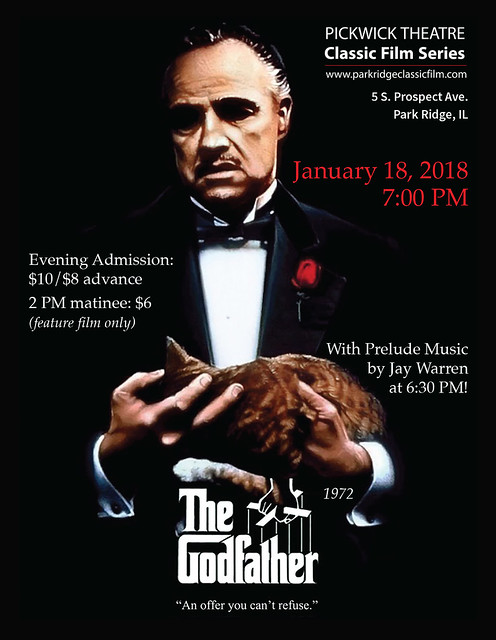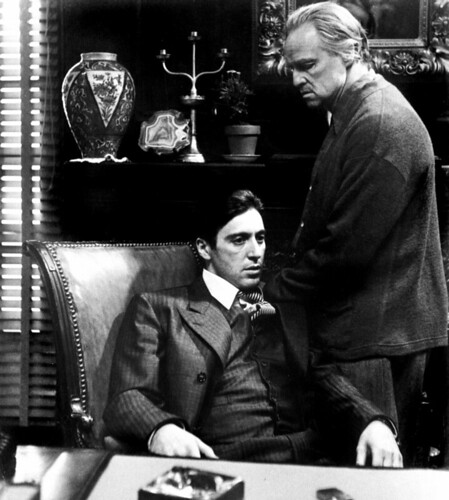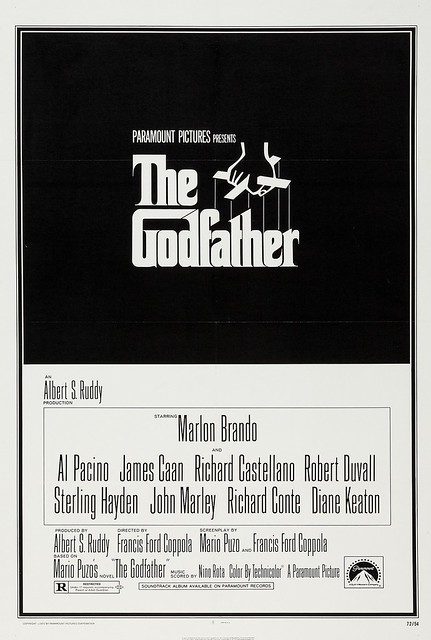WHAT: The Godfather (1972) presented in a DCP restoration
WHEN: January 18, 2018 2 PM & 7:00 PM
WHERE: Pickwick Theatre, Park Ridge, IL
WHAT ELSE: Organist Jay Warren performs prelude music at 6:30 PM.
Prize drawing at 7 PM. Enter name/email at the table in the lobby for a chance to win.
HOW MUCH: $10/$8 advance (before Thurs.) or $6 for the 2 PM matinee
Francis Ford Coppola’s gangster epic, The Godfather (1972), is a landmark film in American cinema. In 2007, the AFI ranked it #2 on their list of Greatest Films, and it’s at or near the top of just about every other list. The first in the Godfather saga is one of the most iconic films of the 1970s– a film that not only influenced Coppola’s contemporaries like Martin Scorsese with Mean Streets, but inspired a whole new generation of filmmakers. The film’s performances, particularly the Oscar-winning role of Marlon Brando, have become legendary with lines of dialogue that are now ingrained in our culture. Television shows like The Sopranos referenced it with characters who came off as distant cousins to the Corleone family. The Godfather has become so much a part of our lives, particularly in the male population, that it’s opened itself up to satire. But whether it’s in television or cartoons, the satiric aspects are more of a homage than anything else. In hindsight, the film seemed destined to be a classic with a director well-suited for the assignment. Yet, the reality is that The Godfather was almost sabotaged by its own studio. It could have easily become just another mob movie.
The story was based on the 1969 best-selling novel of the same name by Mario Puzo. After reading it, Francis Ford Coppola was less than impressed with what he considered to be a somewhat sleazy “potboiler.” In order to translate it to the screen, Coppola zeroed in on the best parts of the novel. He envisioned the story as a metaphor for capitalism in post-war America, as seen through the experiences of one family. He was particularly drawn to the story of a father and his three sons; Vito Corleone ruled liked a king, and it became a story of succession. There was a Shakespearian dimension to it harkening back to classics like King Lear. While building upon the foundation that Puzo had poured, Coppola removed the lurid elements and irrelevant subplots that did not work. What he created was a riveting tale about a modern-day Borgia family.
In the post-World War II years in which the story is set, The Godfather presents a picture of the world that is corrupt from the top down. The Corleone family is like the government– only they do things their own way. When the legal system fails the people and there is no justice to be found, citizens– as though living in the days of old Rome– petition their “Godfather” for favors. The film romanticizes the mob with their rituals and code of conduct. To fully articulate the richness of the saga, Coppola made what in the theatre tradition is called a prompt book; these detailed notebooks contained all the stage direction. Using the actual pages from the Puzo novel, Coppola made copious notes and worked out all the details that would bring texture to the movie version. These notations have recently been put into book form and published as The Godfather Notebook (2016).
A page from Coppola’s notebook…

During pre-production, Francis Ford Coppola worked closely with Mario Puzo on the writing of the screenplay. As a show of his appreciation, Coppola gave him the screen credit: Mario Puzo’s The Godfather. Just a couple years earlier, Coppola had co-written the screenplay for Patton (1970), which opens with a memorable speech given by George C. Scott. When a friend of Coppola’s saw his mob story, which at that time opened with the Corleone wedding, he suggested to the director that it begin with something more unique– something other than just the wedding. Coppola thought about this and remembered the striking opening he had written for Patton. He then came up with the “I believe in America” speech that begins the film. It is spoken by the undertaker, a man who seeks a favor from Vito Corleone in the Don’s study.
Paramount simply wanted to cash in on the growing popularity of the novel and intended on making a lower-budget potboiler for 2.5 million. The studio executives originally wanted The Godfather to be a contemporary film set in St. Louis. In addition to the budget and location, the studio was against the casting of Marlon Brando, who at that time was considered box office poison, and Al Pacino. Coppola’s persistence got both actors hired, and in fact, it was always Al Pacino’s face he saw when he envisioned the scenes set in Sicily. After just a week of shooting, the studio was unhappy with their director. Coppola talks about these issues in his audio commentary for the dvd release. In the most stressful circumstances possible, he shot the film with the expectation that he would be fired at any time. Some of the reasons included the fact that the studio men believed he was in over his head, that he was falling behind on the shooting schedule, and that he wasn’t an “action” director. Coppola tells the story of how he, like the Godfather character, made a preemptive strike by firing those on the production team who were pushing for his termination.
One of the pivotal scenes in the film, Michael Corleone’s meeting with Sollozzo at the restaurant, not only convinced the studio to ease up on Coppola, but it also assuaged their fears concerning Pacino’s abilities as an actor. Eventually, the execs were won over by both Brando and Pacino. For the latter, this was a star-making role. Years before he became an over-the-top parody of himself, Pacino delivered a brooding and understated performance as the calculating, master manipulator, Michael Corleone. It’s one of the great performances in cinema. James Caan as Sonny Corleone and Robert Duvall as the consigliere, Tom Hagen, also stand out in roles that would be turning-points in their respective careers. The cast– from the major figures down to the memorable bit players– is exceptional. Interestingly, Coppola did not exclusively cast “known” actors. Besides Salvatore Corsitto, who played the undertaker, Abe Vigoda was discovered in an open casting call and was given the role of Tessio.
The Godfather is one of the screen essentials primarily because of its story and cast, but there is so much more to this film to be appreciated– from Gordon Willis’ cinematography to Nino Rota’s musical score. There’s a reason why there is no shortage of books that analyze every aspect of its production. Having watched it again recently in preparation for our screening, I was struck immediately by the vitality of the very first scene at the Corleone wedding. It feels like we, the audience, are observing a real Italian wedding. Coppola beings so much detail about Italian-American life because of his own background. All this is weaved into a twenty-six minute sequence that introduces the main characters of the story. In the crowd there are also members of Coppola’s own family. Many of whom appear throughout the film, including his mother, his father, and his sister, Talia Shire, who plays Connie Corleone. As Coppola relates in his audio commentary, The Godfather is a film about a family and made by a family.
There is a real feel for the time period in The Godfather. The film is set in 1945 and continues into the mid-1950s. It’s a stylish recreation of a time that harkens back to Old Hollywood. Coppola deliberately shot the film in the classic Hollywood style. This was perhaps another reason why the studio wasn’t impressed with the results; The Godfather is a throwback to an earlier time, and its filmmaking style was not in sync with the times, although its cynical tone certainly was. To his credit, Coppola had a vision of what the film should be, and he remained true to the period of the book. It’s hard to imagine The Godfather set in the 1970s and populated with hippies in the background! Insisting that this be a period film was one of the primary factors that pushed the budget to 6.2 million– almost three times the original estimate. Though more money had been allotted, there were still many effects that were done inexpensively with some shots improvised. But the film never looks cheap. The filmmakers always seemed to find creative solutions to problems that arose on the set; their ingenuity created a seamlessness in the visual design. It is due to the success of the film that Coppola was able to direct the sequel with far less stress and a much larger budget.
We hope to have a good crowd for this belated 45th anniversary screening of The Godfather. It’s important that the community comes out as we intend on presenting The Godfather II in a later series. NOTE: The Godfather is Rated R.
~MCH


